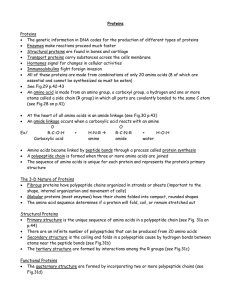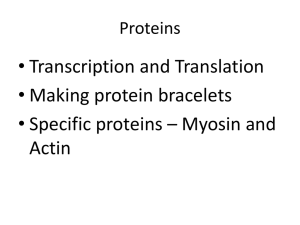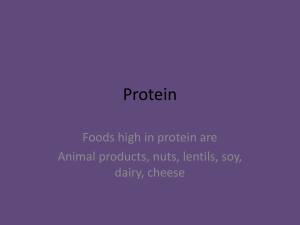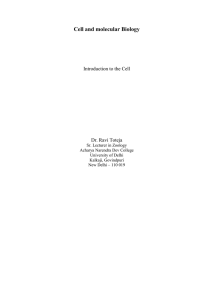Proteins The genetic information in DNA codes for the production of... Enzymes make reactions proceed much faster
advertisement
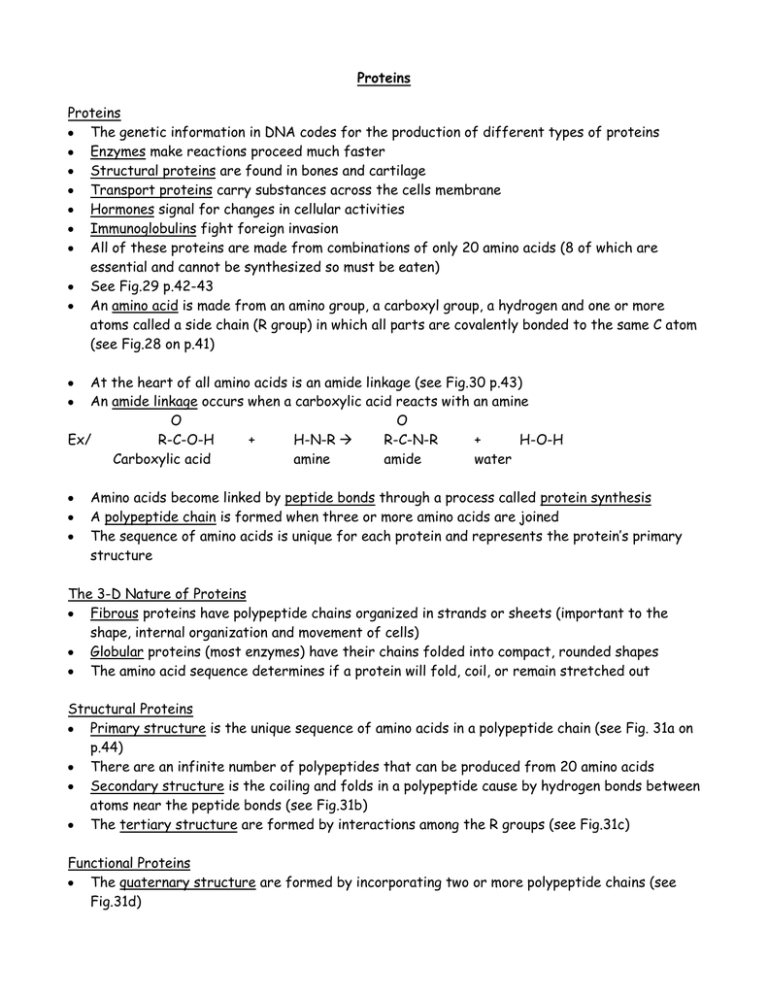
Proteins Proteins The genetic information in DNA codes for the production of different types of proteins Enzymes make reactions proceed much faster Structural proteins are found in bones and cartilage Transport proteins carry substances across the cells membrane Hormones signal for changes in cellular activities Immunoglobulins fight foreign invasion All of these proteins are made from combinations of only 20 amino acids (8 of which are essential and cannot be synthesized so must be eaten) See Fig.29 p.42-43 An amino acid is made from an amino group, a carboxyl group, a hydrogen and one or more atoms called a side chain (R group) in which all parts are covalently bonded to the same C atom (see Fig.28 on p.41) At the heart of all amino acids is an amide linkage (see Fig.30 p.43) An amide linkage occurs when a carboxylic acid reacts with an amine O O Ex/ R-C-O-H + H-N-R R-C-N-R + H-O-H Carboxylic acid amine amide water Amino acids become linked by peptide bonds through a process called protein synthesis A polypeptide chain is formed when three or more amino acids are joined The sequence of amino acids is unique for each protein and represents the protein’s primary structure The 3-D Nature of Proteins Fibrous proteins have polypeptide chains organized in strands or sheets (important to the shape, internal organization and movement of cells) Globular proteins (most enzymes) have their chains folded into compact, rounded shapes The amino acid sequence determines if a protein will fold, coil, or remain stretched out Structural Proteins Primary structure is the unique sequence of amino acids in a polypeptide chain (see Fig. 31a on p.44) There are an infinite number of polypeptides that can be produced from 20 amino acids Secondary structure is the coiling and folds in a polypeptide cause by hydrogen bonds between atoms near the peptide bonds (see Fig.31b) The tertiary structure are formed by interactions among the R groups (see Fig.31c) Functional Proteins The quaternary structure are formed by incorporating two or more polypeptide chains (see Fig.31d) Denaturation occurs when molecules lose their 3-D shape following the disruption of weak bonds the protein may uncoil or assume a new shape once the physical or chemical factor is removed, the protein may assume its original shape when the change in protein shape is permanent, coagulation is said to have occurred This can be caused by changes in temperature, pH, ionic concentration or other environmental factors Nucleic Acids Nucleic acids store hereditary information that determines the structure and function of living things These instructions are encoded in a coiled chain of deoxyribonucleic acid (DNA) Ribonucleic acid (RNA) reads the DNA and transports the instructions for making protein to the ribosomes in the cell Both DNA and RNA are nucleotide polymers that consist of a 5 carbon sugar (ribose or deoxyribose), a phosphate group, and a nitrogenous base (see Fig. 42a on p.53) There are five nitrogenous bases: adenine (A), and guanine (G) are double-ring purines, while cytosine (C), thymine (T), and uracil (U) are single-ring pyrimidines (see Fig.42c) DNA contains A,T,G and C, while RNA contains A,G,U, and C DNA is a double stranded molecule (running antiparallel to one another) held together by hydrogen bonds Adenosine triphosphate (ATP) is a nucleotide used to deliver energy from one reaction site to any other reaction site Other important molecules include NAD+ and FAD (used to make ATP), NADP+ (used in photosynthesis), and cAMP (used as a messenger in hormone interactions)




